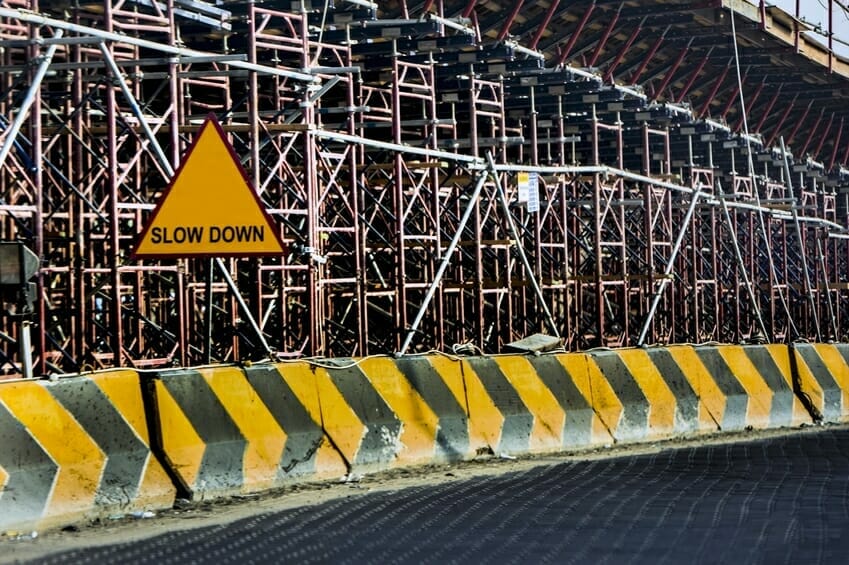As the state’s roadway infrastructure continues to expand, the price of progress means more than 2,500 active highway construction and repair work zones. According to the Texas Department of Transportation (TxDOT), in 2017 there were over 27,000 work zone crashes in Texas. That’s an increase of 5% over 2016’s accident count, totaling almost 100 deaths and over 800 serious injuries. The leading causes were speeding and driver inattention/distraction, both of which are preventable if drivers pay attention and slow down in work zones. Fines for traffic violations in work zones double – because vulnerable workers are present – and can be as high as $2,000.
Some tips that can save you money and a roadside construction worker’s life include the following:
Slow down, be alert, and pay attention to the signs – Diamond-shaped orange warning signs are generally posted in advance of road construction projects and flashing message signs will communicate warnings and instructions.
A truck traveling at 60 mph covers 88 linear feet per second. If you’re driving 60 mph and encounter a sign that says “Road Work 1,500 feet,” you’ll be in that work zone in less than 20 seconds.
Expect the unexpected in road construction zones – By obeying lower speed limits, watching for sudden traffic lane changes, and being alert for people and construction vehicles near the highway, you can easily cruise through a work zone without incident.
Follow directions given by the flagger – Be prepared to immediately obey the flagger’s directions. In construction zones, fines await those who are caught disregarding a flagger’s orders.
Keep cool in road construction zones – Delays can be exasperating, but getting upset and venting accomplishes nothing except raising your blood pressure and putting you in a sour mood. If you can’t find an alternative route to avoid construction zones – detours which can sometimes be just as jammed-up as the zones themselves – relax, and go with the flow. It’s only temporary.
Use the “Take 10” technique to change lanes – Many construction zone accidents happen during improper or impatient lane changes. When encountering flashing arrow panels or “lane closed ahead” signs, merge as soon and as safely as possible. Don’t zip into the lane or force yourself in. The “Take 10” technique involves signaling for at least three seconds once you’re aware of the need to change lanes. Then use at least seven seconds to smoothly change lanes; all the while darting your eyes to your mirror, the road in front of you, and peripherally when you encounter workers or equipment in lanes adjacent to you.
Drive defensively and try not to follow too close – The most common crash in a highway work zone is the rear-end collision, often happening during lane changes. Try to keep seven seconds of braking distance between you and the vehicle ahead of you. Sometimes that’s not possible due to traffic congestion, so in road work zones, be prepared to brake in the blink of an eye.
Also be aware of traffic barriers, construction equipment, and workers. They deserve the right to go home safely each day just like everyone else.
Obey the posted signs until you see the “end work zone” sign – Some work zones – such as those where workers are painting lines, patching roads, or mowing — move down the road with traffic. Just because you don’t see the workers in the posted work zone doesn’t mean they’re not out there. Also, keep your eyes out for workers helping to move the zone forward by picking up and putting down cones at the ends of the zone.
Expect delays and leave early to reach your destination on time – TxDOT uses many channels to inform motorists about the location and duration of major work zones. Choose your favorite information channel, plan ahead, stay alert, and keep calm so everyone gets home safely.
Attorney Terry Bryant
 Terry Bryant is Board Certified in personal injury trial law, which means his extensive knowledge of the law has been recognized by the Texas Board of Legal Specialization, setting him apart from many other injury attorneys. The 22 years he spent as a Municipal Judge, Spring Valley Village, TX also provides him keen insight into the Texas court system. That experience also helps shape his perspective on personal injury cases and how they might resolve. This unique insight benefits his clients. [ Attorney Bio ]
Terry Bryant is Board Certified in personal injury trial law, which means his extensive knowledge of the law has been recognized by the Texas Board of Legal Specialization, setting him apart from many other injury attorneys. The 22 years he spent as a Municipal Judge, Spring Valley Village, TX also provides him keen insight into the Texas court system. That experience also helps shape his perspective on personal injury cases and how they might resolve. This unique insight benefits his clients. [ Attorney Bio ]


 Terry Bryant is Board Certified in personal injury trial law, which means his extensive knowledge of the law has been recognized by the Texas Board of Legal Specialization, setting him apart from many other injury attorneys. The 22 years he spent as a Municipal Judge, Spring Valley Village, TX also provides him keen insight into the Texas court system. That experience also helps shape his perspective on personal injury cases and how they might resolve. This unique insight benefits his clients. [
Terry Bryant is Board Certified in personal injury trial law, which means his extensive knowledge of the law has been recognized by the Texas Board of Legal Specialization, setting him apart from many other injury attorneys. The 22 years he spent as a Municipal Judge, Spring Valley Village, TX also provides him keen insight into the Texas court system. That experience also helps shape his perspective on personal injury cases and how they might resolve. This unique insight benefits his clients. [ 

